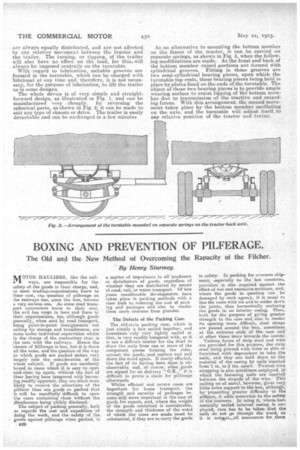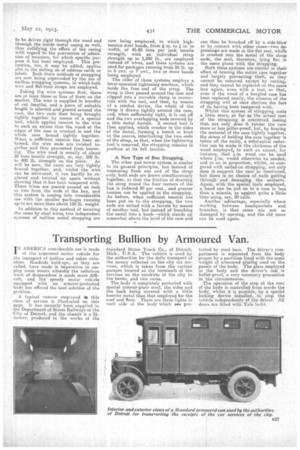BOXING AND PREVENTION OF PILFERAGE.
Page 12

Page 13

If you've noticed an error in this article please click here to report it so we can fix it.
The Old and the New Method of Overcoming the Rapacity of the Filcher.
By Henry Sturmey.
MOTOR HAULIERS, like the railways, are responsible for the safety of the goods in their charge, and, as most tradineLorganizations know to their -cost, the question of pilferage on the railways has, since the war, become a very serious one As some road transport, contractors know to their cost, the evil has crept in here and there in their organizations, too, although goods generally, when sent by road transport, being point-to-point consignments not calling for storage and. transference, are more under individual supervision whilst in the charge of the contractors than is • the case with the railways. Hence the chance of pilferage is less but, it is there .q all the same, and theueslion of the way in which goods are packed enters very largely into the consideration of the whole subject. If goods are carelessly boxed in cases which it is easy to open • and,close up again, without the fact of their haying been tampered with becom.ing readily apparent, they are much more likely to receive the attentions of the pilferer than are goods so .packed that it, will be manifestly 'difficult to open the eases containing them without, the rhterference being visibly disclosed. The subject of packing generally, both as regards the cost and expedition of doing the work, and the safety of the goods against pilferage when packed, is
B26
a matter of importance to all producers or distributors of goods, regardless of whether they are distributed by means of road, rail, or water transport. Of late years considerable developments have taken place in packing methods with a view both to reducing the cost of packing and packages and also to render them more immune from plunder.
The. Defectsof the Packing Case.
The old-style packing case, which is just simply a box nailed together, and sometimes only very lightly nailed at that, is very readily tampered with, as it is not a difficult matter for the thief to draw the nails from one or more of the component pieces forming the sides, extract the goods, and replace and nail down the wood again. If neatly effected, the fact of its having been done is unobservable, and, of course, when goods are signed for on delivery " O.K.,' it.is difficult to prove a claim for pilferage afterwards.
Whilst efficient and secure cases are important for home transport, the strength and security of packages become still more important in the case of goods for export, and, where the weight of the goods contained is considerable, the strength and thickness of the el:Cod of which the cases are made must be substantial, if they are to carry the goods
in safety. In packing for overseas shipment, especially to the hot countries, provision is also required against the . effect of wet and excessive moisture, and, where the goods in question can be damaged by such agency, it is usual to line the cases with tin and to solder down the joints, thus hermetically enclosing the goods in an interior easing. Then, both for the purpose of giving greater strength to the case and also to render its opening more difficult, steel straps are passed around the box, sometimes at the extreme ends of the case and at other tithes more towards the centre; Various. forms of strip Steel. and wire are provided for this purpose, the strip steel being pierced with holes or slits or furnishedwith depressions to take the' . nails, and they are held down to the material of the casing by nails inserted from1 in. to 2 ins. apart. Twisted wire strapping is also sometimes employed, i. which the fastening nails are inserted between the strands of the wire. Thia nailing on of metal, however, gives very little extra support to the box, although; by presenting greater difficulty to the pilferer, it adds soMewhat to the Safety of the contents. In using it, where her;. metically sealed internal .casing is ere= ployed, care has to be taken -that the nails do not go through the wood, as it is notxat,„all uncommon for ,thein
to be driven right through the wood and through. the inside metal easing.as _well, thus nullifying the effect of the casing with regard to the prevention of admission of moisture, for which specific purpose it has been employed. This precaution, too, it may be added, applies also to the nailing on of address cards or labels. Both these methods of strapping are now being superseded by the use of nailless stripping systems, in which both wire and flat-steel straps are employed.
Taking the wire systems first, there are at least three or four of them on the market. The wire is supplied in bundles of cut lengths, and e, piece of suitable length is selected and passed around the case, the two ends then being brought tightly together by means of a special tool, which applies tension to the wire to such an extent that the wood at the edges of the case is crushed in and the whole case bound tightly together. When a .sufficient tension has been at.' tamed, the wire ends are twisted to. get-her and thus prevented from loosening. The wire used is -usually of about 25 tons tensile strength, or, say, 300 lb: to 400 lb. strength on the piece. As will be seen, the cases are very tightly braced together, and, whilst the wire can be untwisted, it can hardly be replaced and twisted up win without showing that it has been tampered with. These wires are passed around an inch or two from the ends of the box, and a-his system is coming into considerable use with the smaller packages running up to not more than about 150 lb. weight.
In addition to this method of securing the cases by steel wires, two independent systems of nailless metal strapping are
now being employed, in which high-. tension steel bands, from in. to in. in width, of 45-50. tons per -inch tensile strength, with an individual strap strength up to 1,250 lb., are employed instead of wires, and these systems are used for packages running from 50 lb. up to.6 cwt. or 7 cwt., two or More bands being employed.
The older of these systems employs a lever-operated tightening machine, which holds the free end of the strap. The strap is then passed around the case and slipped into a movable clamp in connection with the tool, and -then, by means of a ratchet device, the whole of the strap is drawn tightly around the case, and, when sufficiently tight, it is cut off and the two overlapping ends covered by a thin metal ferrule. A second tool is then applied, which crushes in the sides ef the metal, forming a bunch or knot in the centre, interlocking the two ends of the strap, so that, when the tightening tool is removed, the strapping remains in position at its full tension.
A New Type of Box Strapping.
The other and newer system is similar in its general principles, but, instead of tensioning from one end of the strap only, both ends are drawn simultaneously together, so that the friction of drawing the strap round the four corners of the bee is reduced 50 per cent., and greater tension can be applied to the strapping. As before, when sufficient tension has been put on to the strapping, the two ends are united with a ferrule by means of another tool, but instead of bunching the metal into a knob—which stands up somewhat above the level of the ease and can thus be knocked off by a side-blow or by contact with other cases—two depre.ssioSs are made in the flat seal, whi6h is crushed into the metal of the strap ends, the seal, therefore, lying fiat, in the same plane with the strapping.
Both these systems are similar in their effect of bracing the entire case together and largely preventing theft, as they cannot be removed except by cutting, and they cannot be replaced on the same box again, even with a tool, so that, even if the wood of a burgled case has been replaced neatly, the absence of the strapping will at once disclose the fact of its having been tampered with.
Whilst this system of strapping costs a, little more, so far as the actual cost of the strapping is concerned (seeing that not only does it render the case more or less pilfer-proof, but, by bracing the material of the case tightly together, the stress of holding the case together is taken off the nails), a substantial reduction can be made in the thickness of the wood employed, to such an extent,for instance, that f-in, wood can be used . where Zen. would otherwise be needed, and so on in proportion, whilst, as compared with nailed-on strapping, not only does it support. the case as mentioned, but there is no chance of nails getting throughand damaging the *entente. Again, with the special tools employed, a band can be put on to a case in less than a. minute; as against quite a little time using, say, 50 nails.
Another advantage, espeeially where working between headquarters and branches, is that cases are not so damaged by opening, and the old cases can be used again.


































